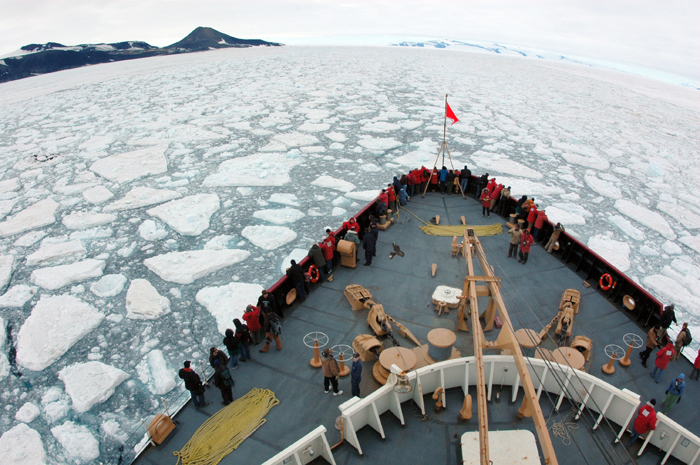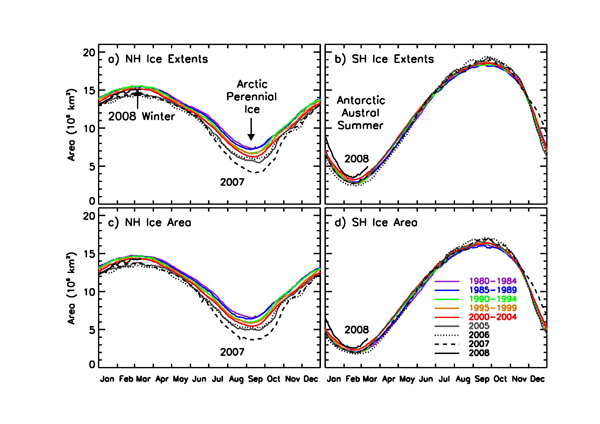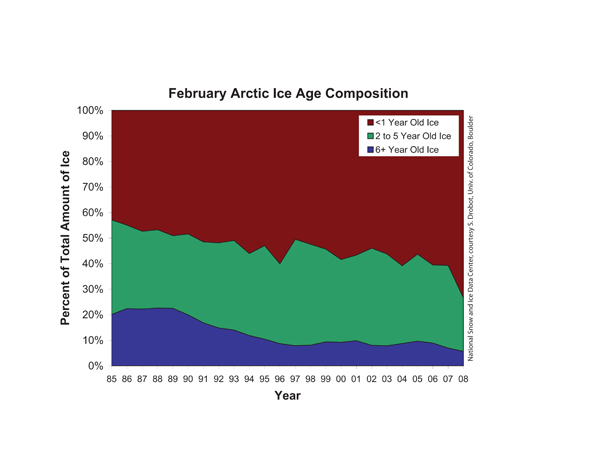|
The score on sea iceAntarctic appears fairly healthy, while Arctic volume continues steep declinePosted April 4, 2008
Antarctic sea ice remains relatively healthy while the sea ice in the Arctic continues a precipitous decline in overall volume. More Information
That’s the latest state of the union report from NASA, which held a teleconference for the media on March 18, with three scientists presenting the latest analysis from satellite data. NASA satellite records on sea ice extent go back about 40 years. “The area of Antarctic ice has been relatively stable in the past 35 years,” said Seelye Martin, program manager of Cryospheric Sciences in the Earth Science Division at NASA headquarters in Washington, D.C. Martin said sea ice extent in the Antarctic has increased about 1 percent per decade during that time. “In other words, it’s basically staying constant,” he said. The news is far more grim in the Arctic, despite a slight increase in overall winter sea ice extent in March, when the sea ice pack peaks in the northern hemisphere. The concern is that the perennial sea ice — the thick, multi-year ice that survives through more than one summer — is rapidly declining in the Arctic. “The area of the thicker, perennial ice has reached an all-time minimum,” Martin said. “In other words, the volume of the Arctic pack ice is continuing to decrease.” Perennial ice used to cover 50 to 60 percent of the Arctic, but this year it covers less than 30 percent, according to NASA data from the satellites. Very old ice that remains in the Arctic for at least six years comprised over 20 percent of the Arctic area in the mid to late 1980s, but this winter it decreased to just six percent. In 2007, perennial sea ice was 38 percent below the 28-year average, said Josefino Comiso, senior research scientist at the Cryospheric Sciences Branch at NASA’s Goddard Space Flight Center in Greenbelt, Md. “Considering that the perennial sea ice cover has been persistently low in recent years, this unusual drop in perennial ice cover in 2007 was a big event, and may be a turning point in the Arctic sea ice,” Comiso said. However, he advised caution in interpreting the anomaly, particularly because of other climatic events that would have induced unusual melting that year. Polar sea ice is important for several reasons. The ice reflects light from the sun, but as it begins to melt, it reflects less sunlight back into space. Instead, the oceans and land absorb the light and heat, raising the overall temperature, and fueling further melting. This creates a positive feedback loop called an ice albedo feedback, which causes the loss of the sea ice to be self-perpetuating: The more it disappears, the more likely it is to continue to disappear. In addition to helping regulate heat — serving as a sort of air conditioner for the planet — sea ice serves as a vital habitat for the Arctic’s polar bears. In the Antarctic, winter sea ice is important to links all across the food chain, from the shrimp-like krill at the bottom to Adélie penguins at the top. Sea ice operates differently in Antarctica, where historically little perennial sea ice survives each summer season. During the winter, sea ice covers up to 18 million square kilometers of ocean, but by the end of summer, only about 3 million square kilometers of sea ice remain. The difference is that Antarctica is land surrounded by ocean, while the Arctic is ocean surrounded by land. The Southern Ocean around Antarctica allows the sea ice to move more freely than it does in the northern hemisphere, and so the sea ice floats northward into warmer waters where it eventually melts. The surrounding ocean and the Antarctic Circumpolar Current also help isolate and buffer the continent from warmer weather. The scientists at the NASA press conference noted there is some strong regional variability in sea ice extent around Antarctica. “Even though the Antarctic ice has remained constant in overall extent, it is changing from region to region, and one of the regions where we’re losing ice extent is around the peninsula,” Martin said in response to a question about the changes in melting of Antarctic winter sea ice. U.S. Antarctic Program scientists have said the peninsula, particularly the northern tip, is heating up faster than just about anywhere else on the planet. And winter sea ice is forming later and melting earlier — with the season declining by about three months since the late 1970s. (See story: Getting warmer.) “It is a source of concern for us,” Martin said of the retreat in sea ice along West Antarctica. But the focus of most concern is the Arctic, which appears to be growing dangerously thinner each year. “[Depth is] a key parameter in determining the long-term health of the sea ice, because the thicker ice is more resilient to any short-term changes in weather … It’s tough as nails. It’s the Gen. Patton of sea ice, so to speak. It is resistant to short-term melting,” explained Walter Meier, with the National Snow and Ice Data Center (NSIDC) at the University of Colorado, Boulder, Colo. The NSIDC receives part of its funding from the National Science Foundation. Meier used an analogy of a Hollywood set to make his point: On the surface, the buildings of the set look real, but when you look behind the façade, there is nothing there. “What we’re seeing with the ice cover is that it’s becoming more and more empty,” Meier said. “We’re getting thinner and thinner ice, and that ice is much more susceptible to melting during the summer of any type, and it’s most likely to melt away.” |



For USAP Participants |
For The Public |
For Researchers and EducatorsContact UsNational Science FoundationOffice of Polar Programs Geosciences Directorate 2415 Eisenhower Avenue, Suite W7100 Alexandria, VA 22314 Sign up for the NSF Office of Polar Programs newsletter and events. Feedback Form |




